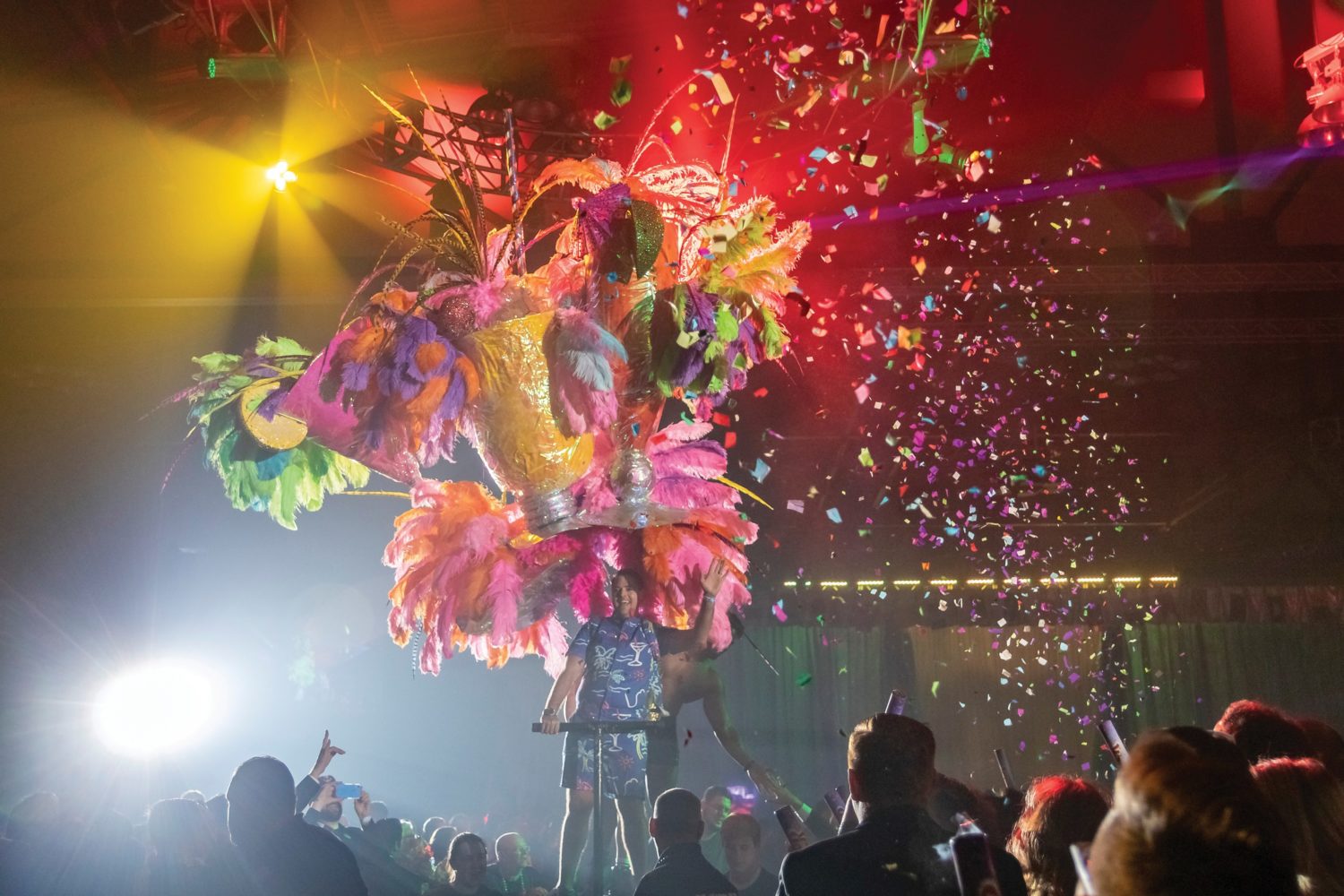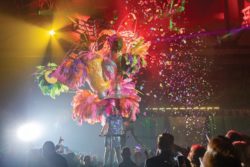Gay Carnival
Since the mid-twentieth century, LGBTQ+ residents of Louisiana have contributed unique traditions to Mardi Gras celebrations.

Jonathon Silver Ahhee
Krewe member Jacque Rowe at the Mystic Krewe of Apollo de Lafayette’s Bal Masque XLIII in 2019.
Gay Carnival traditions began in mid-twentieth-century New Orleans as a gender-bending parody of elite Mardi Gras traditions, particularly the humorless coronation balls of aristocratic, segregated clubs like Rex and the Mistick Krewe of Comus. After the rise of gay Carnival krewes in the 1960s and 1970s, queer culture became a mainstay of Carnival in New Orleans and a force for LGBTQ+ visibility and community engagement in Louisiana.
Queer Beginnings
Early accounts of Carnival prominently featured gender play. In the first written reference to Mardi Gras in New Orleans, Marc-Antoine Caillot, a bureaucrat working for the Company of the Indies, noted the following. “Lundi Gras, I went to the office where I found my companions bored to death,” he wrote in his journal in 1729. “I proposed to them that we mask and go to Bayou St. John. … As for myself, I was dressed as a shepherdess, all in white. I had a corset of white bazin.” In addition to cross-dressing during the French colonial period, early newspaper accounts of Mardi Gras from the 1830s noted men “dressed in female attire” that “acted the lady with no small degree of grace.” It must be qualified, however, that the sexualities of these cross-dressing men remain unknowable in an era without ready terminology.
Despite the legacy of the cross-dressing amateur, puritanical attitudes arrived in the state with the 1803 Louisiana Purchase as new American residents brought religious ideologies stigmatizing sex and the body. In 1870, for example, New Orleans police threatened feminist activist Mary Walker with arrest after Mardi Gras “if she appear[ed] again in the streets in her half man and half woman costume.”
By 1924 anti-masking bills passed in Baton Rouge to curb the rise of the Ku Klux Klan were repurposed to control gender expression and made it illegal to costume in drag, or cross dress, in public places except for festive occasions like Mardi Gras Day. One of Mardi Gras Day’s great allures for gay men, therefore, was the ability to express oneself in costume and, in a sense, be seen in public without fear of arrest. Gay life and masking became correlated concepts in this era, as gay men often literally masked themselves while in Mardi Gras costume and also symbolically masked themselves as “bachelors” to avoid discrimination when Carnival ended. “I was raised to be a polite young gentleman,” recalled gay Carnival pioneer John Henry Bogie in the 2010 documentary The Sons of Tennessee Williams. “We did not discuss my being gay.”
Emerging Stars
Gradually, gay men challenged anti-masking laws and societal conventions. The first gay Mardi Gras club, the Fat Monday Luncheon, began in 1949. This traditional restaurant brunch for gay friends culminated in the reveal of a tiara and the crowning of one guest as “queen” of the luncheon. When the Krewe of Yuga, the first gay Mardi Gras krewe, formed in 1958, they took gender-play to a new level by holding private drag balls, where gay men put on women’s attire and presented themselves as “queens,” or goddess figures. Authorities responded forcefully to Yuga’s provocations. In 1962, Jefferson Parish police raided the Yuga ball at a private venue in Metairie and arrested 96 men for “disturbing the peace.”
The Yuga raid provoked a response that marked a turning point for gay Carnival. Dixie Fasnacht, owner of Dixie’s Bar of Music, a popular Bourbon Street gay bar with a side door “For Male Bachelors Only,” knew many Yuga members. When Fasnacht learned of the raid, she placed money from her till into a paper bag and dispatched her attorney to bail out the arrestees. “The raid didn’t end gay Mardi Gras,” remembered Ray Durand, who was at Dixie’s that evening. “It kicked it off. It put more anger out on the street among gay guys.”
Although Yuga was no more, its spirit flourished through former members, and the krewes of Petronius (1961), Amon-Ra (1965), Ganymede (1967), Olympus (1970), and Apollo (1970) formed out of white gay cliques, mirroring the racial segregation of Louisiana. The Krewe of Armeinius broke that barrier in 1968 by becoming the first gay krewe with a Black co-founder: Nat Haydel. As homosexual association remained illegal, no gay krewe could risk sponsoring a parade or public event that would identify—or “out”—its membership and imperil their safety.
The Gay Heyday
Seeking legal cover in 1966, Petronius became the first gay krewe in Louisiana to incorporate and obtain a state charter to operate a Mardi Gras organization. Going “legitimate,” as Petronius co-founder Bill Wooley put it, had the effect of gay krewes upgrading their balls into formal affairs requiring tuxedos, gowns, and/or upscale drag and tickets demanded at the door. As Armeinius founder Wendell Stipelcovich attested, Mardi Gras parody gave way to “Mardi Gras pretty, an elevated pursuit of production and stagecraft.” For example, in 1972 Apollo became the first gay krewe to hold a ball at the Municipal Auditorium, where the elite courts of Rex and Comus traditionally met.
A typical gay ball in New Orleans differed markedly from mainstream balls by eliminating cotillion-like processions of upper-crust women and making gay men the stars of each “tableau,” or staged scenes with costume, music, and décor curated around a theme. Gay ball themes ranged from the fantastical, such as “Camelot,” to the conceptual, such as “Wicked Bitches of History.” The popularity and production value of gay balls increased side by side, and gay krewe members began investing hundreds, if not thousands, of dollars each year to premier extravagant ball tableaux (French for “tableaus” and the preferred term in krewe lingo) to gay society.
Starting in the mid-1960s gay krewes began formally competing for “best of” titles at the annual Bourbon Street Awards, where rhinestones and glitter ruled the 900 block of Bourbon Street on Mardi Gras Day. As the hype became amplified, tickets to gay balls were coveted by celebrities like transgender activist Christine Jorgenson and Rolling Stone journalist Hunter S. Thompson. “The gay balls of New Orleans are even more elite than those given by straight society,” touted the gay New Orleans newspaper Impact in 1979. “It is not unusual to see a member of Comus go begging for a ticket to a gay tableau.”
Community Strength
Although primarily social in nature, gay krewes occasionally flexed their influence by taking stances against public figures with anti-homosexual agendas. In 1969 Orleans Parish District Attorney Jim Garrison’s infamous trial outed elite New Orleanian Clay Shaw by accusing Shaw of conspiring to assassinate President Kennedy as a “homosexual thrill killing.” Though Shaw was duly acquitted, the nature of his outing tarnished his reputation and public perceptions of queer people. Leaders of gay krewes met in 1972 at the invitation of opposing district attorney candidate Harry Connick Sr. Appealing to the gay community, Connick gave a presentation at a gay couple’s French Quarter home, where he promised to end the threat of police raids on local gay bars. Connick would go on to unseat Garrison.
In response to a planned 1977 concert series at the Municipal Auditorium for celebrity singer and anti-homosexual spokesperson Anita Bryant, all but two gay krewes joined a political coalition called Human Equal Rights for Everyone (HERE). Opposing Bryant’s views and contesting the public funds supporting her visit, HERE organized one of the largest gay rights rallies in the early history of the LGBTQ+ rights movement in Louisiana at New Orleans’s Jackson Square.
Expanding the Dream
At its peak, with more than a dozen gay krewes in New Orleans, gay Carnival spread regionally. In 1977 the Krewe of Apollo expanded from New Orleans into Birmingham, Alabama, and more Apollo franchise krewes followed in cities like Baton Rouge, Dallas, Lafayette, and Shreveport. The Baton Rouge and Lafayette franchises outlasted the 1986 collapse of Apollo’s “mother krewe” in New Orleans, which eventually inspired it to reestablish itself and hold a “Resurrection Bal Masque” in 2020. As another example, in 1991 New Orleans’s Krewe of Olympus transplanted to Houston, Texas, where it revels into the present day.
By the 1980s gay Carnival took steps to become more racially and gender inclusive. Legacy krewes such as Amon-Ra and Petronius as well as the more contemporary Lords of Leather, a leather-lifestyle-oriented gay Carnival krewe, crafted or amended bylaws to accept female membership. The first lesbian krewe, Ishtar, formed in 1981 and reveled for five years. Addressing racial exclusion, Polyphemus, the first gay krewe to recruit gay Black membership, was founded in 1983. The following year, New Orleanian Michael Hickerson became the first Black member of Amon-Ra. “The night I got into the organization, there were some whites who didn’t,” Hickerson remembered. As a result, several Amon-Ra members quit the organization. Hickerson persevered and in 2004 became the first Black queen in Amon-Ra history. The Krewe of Mwindo, a gay Black krewe founded 1998, continues to revel in New Orleans and proudly hosts a ball each season.
Surviving the Plague
The advent of the AIDS crisis heralded an age of decimation for gay Carnival. In 1985, gay krewes in New Orleans worked covertly with sympathetic Roman Catholic priest Bob Pawell to convert an empty convent in the Marigny neighborhood into an AIDS hospice called Project Lazarus. “Imagine kings and queens of gay Mardi Gras scrubbing the floors trying to make the place presentable,” recalled gay Carnival veteran Albert Carey, who served as informal architect of the project. “Some friends who, on that first day, scrubbed the floors ended up being residents of the place.”
Gay balls of the Reagan era turned into fashionable fundraisers for hospice centers like Project Lazarus, which largely operated on volunteers from gay krewes. Meanwhile, krewe members constantly battled anti-AIDS stigma. “It was very sad,” Carey remembered. “You couldn’t tell anyone where Project Lazarus was, because the neighbors would have kicked us out on the street. And that was the only place for people to go at the time.” Some krewes, such as the Celestial Knights, folded or consolidated when entire circles of membership got sick. Yet the balls persisted in full glamour, in large part to honor the revelers who perished.
Over the Rainbow
Though gay krewes face a generational dilemma, with gay men now openly serving as kings and captains of mainstream krewes and gay-exclusive spaces disappearing nationwide, gay Carnival remains a highlight of Mardi Gras season in New Orleans, Lafayette, Houston, and Mobile. The Fat Monday Luncheon in New Orleans still meets, representing one of the most enduring gay traditions in America. Some newer gay krewes, conversely, have sought out fresh niches within Carnival conventions. For example, the Krewe du Rue Royale Revelers hosts a Twelfth Night Party instead of a ball, and the Krewe of Queenateenas holds a “King Cake Queen” coronation party as well as a Mardi Gras Day bead toss. The Krewe of Stars, founded by former gay royalty of the Mystic Krewe of Satyricon, deemphasizes gayness as a qualifier in favor of a “ball for all” philosophy.
In 2010 the filmmaker Tim Wolff released the first feature-length documentary on gay Carnival, The Sons of Tennessee Williams. In 2018 historian Howard Philips Smith published the first compendium of gay Carnival history, Unveiling the Muse: The Lost History of Gay Carnival in New Orleans. And from 2019 to 2020, the Louisiana State Museum devoted a section of the Presbytère to an exhibition entitled Grand Illusions: The History and Artistry of Gay Carnival in New Orleans. Seemingly in the span of one lifetime, gay Carnival’s celebrants went from being outlaws arrested on sight to icons celebrated by the state.
